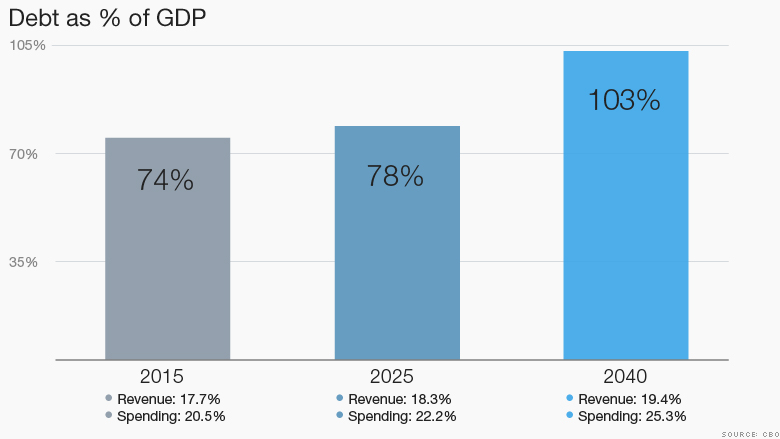
The U.S. budget could look very different in 25 years, even if its tax and spending policies don't change a bit.
How different?
The Congressional Budget Office on Tuesday estimated that revenue flowing into the federal government as well as government spending will both rise as a percent of the economy, but spending growth will far outpace revenue growth.
As a result, the country's accumulated public debt could top 100% of gross domestic product by 2040, up from 74% today, the CBO said in its long-term budget outlook, the first published under the agency's new director, Keith Hall.
Where the money will go: How the government spends the money it gets will shift pretty dramatically.
Due to the aging of the population, rising health costs and rising interest rates, an ever-increasing share of U.S. revenue will go to the country's biggest entitlement programs, including Medicare and Social Security, as well as to interest on the debt.
But federal spending on everything else the federal government does, from education and defense to research and food safety -- is on track to fall to 6.9% of GDP, well below its long-term average of 11.6%.
The effect for individuals is that the check they write to the IRS may go up while the money the government spends on programs that matter to them may not pay for as much as it used to.
Related: U.S. deficit to 'hold steady' until 2018
For instance, CBO estimates that a couple with two kids might pay 16% of their income in federal taxes today. By 2040, that bite could be 19%.
That's because their income is likely to grow but many parameters in the tax code are not indexed for inflation or real income growth, the agency said. So more of their income could be subject to taxes.
How the outlook could change: The chance that tax and spending policies will remain static is next to nil. The question then becomes, will changes improve or worsen the fiscal outlook?
For example, if lawmakers made permanent or further extended so-called "temporary" tax breaks, that would worsen the long-run debt picture. As it is, tax breaks -- permanent and temporary -- are valued at about 8.1% of GDP this year. That's revenue that never gets paid. And it's more than the country spends today (6.5%) on domestic programs.
Of course, some tax breaks are good for the economy -- spurring investment and growth.
So the politically difficult task for lawmakers will be to decide which ones are worth keeping and which aren't.
Another difficult task: Deciding when and how to curb the long-term growth in accumulated debt.
Say Congress wants to make sure the debt doesn't exceed 74% of GDP by 2040. If they started today, that means they would either need to cut spending by 5.5%, raise taxes by 6% or some combination of the two.
"Precipitous spending cuts or tax increases would give people little time to plan and adjust to [them], and the changes would weaken the economic expansion during the next two years or so," the CBO said.
On the other hand, the longer lawmakers wait to act, the steeper the spending cuts and tax increases would need to be.
A possible third way: Lawmakers could make decisions about what to do now, but implement the changes later.
"[Doing so] could make output and employment higher in the next few years than they would have been otherwise," the agency said.


